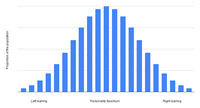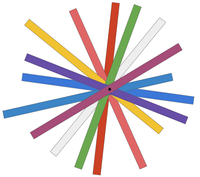Spectrum of personality traits and the personality star
Any personality trait (such as: which side of the fence you sit on politically; whether you're a thinker or a do-er; if you're gregarious or reserved; or you prefer to think strategically over tactically) can be placed somewhere along a spectrum.
For example, an outgoing person with relatively conservative views on life, who likes to take action and make an immediate difference will sit on different parts of the spectra to a left-leaning philosopher.
Person 1:
Left |----------------------------- * ------------------------| Right
Thinker |------------------------------- * ----------------------| Actioner
Gregarious |-------------------- * ---------------------------------| Reserved
Tactical |------------------------ * -----------------------------| StrategicPerson 2:
Left |---------------------- * -------------------------------| Right
Thinker |------------------------ * -----------------------------| Actioner
Gregarious |----------------------------------- * ------------------| Reserved
Tactical |------------------------------- * ----------------------| StrategicThere are many more personality traits than the ones listed above. With over a hundred thousand adjectives in the English language and thousands of pairs of antonyms I assume you could put together a large list - impractical, but no doubt interesting to compile. Perhaps a task for another day?
If we were to study a large, random population and measured where they tended to lie on the spectrum of a given personality trait, it would be likely that there would be a normal distribution of people, i.e. you would find most people lie somewhere the near middle of the spectrum; a smaller number of people would lie to the left or right; and an even smaller number of outliers would be found at the extreme ends of the spectrum.

Where we sit on the spectrum is never static. In fact, I believe the position is constantly moving - sometimes violently - in response to emotional triggers such as a magazine article about an injustice, a distressing piece of news, or an inspiring call to action. In the absence of those emotional triggers the personality traits will naturally fall back to somewhere near the centre. Balance is restored.
Depending on the environment in which the person puts themself, they may find they are moving slowly and progressively towards one side of certain spectra. A case in point is social media and its algorithmically generated social bubbles. You may have sat near the centre of the political spectrum before you started using social media, but the algorithms worked out that they could hold your attention and keep you on the platform longer if they fed you more articles that caused you to lean more strongly towards a certain political side. Balance was lost. The antidote is to delete your social media accounts and start talking to real people again.
I imagine people's personality as a star made up of all their personality trait spectra laid across one another at the point where they currently find themselves. The star 'twinkles' as emotional triggers move the crossing point of some spectra back and forth. A person with balance has a near symmetrical star.

So how can we use this idea to our advantage? If you find that you deviate from the centre of a certain trait, don't worry. You can find balance in a number of ways. For example you could eliminate the triggers that are swaying you in one direction, or introduce good habits to push you gently towards another. Another way is to work with someone from the other side of the spectrum. If you're a person who likes to jump in and just get started on a project you might work well with someone who is all about the planning - to the point where they'll continue to plan and never actually make a start.
The idea can also be used to understand other people. Stephen R. Covey, in his book, "The 7 Habits of Highly Effective People" talked about a paradigm shift in the way you perceive other people, i.e. seeing things from their point of view. This personality star model helps me understand that people's negative attitudes are rarely a choice, but a result of the environment they've been subjected to, whether that be in the immediate past or over a longer period of time. With the right approach you can restore their balance and have productive conversations with them. Although that's a whole other ball-game!
- Previous: Iterative planning
- Next: Get familiar with normal
